Red braised fish aka Hong Shao Yu, is a very common dish in Chinese and Taiwanese cuisine. It is made with rice wine, ginger, scallions, soy sauce, and the star ingredient of chili bean paste.
Why is it called Red Braised Fish?
This dish is called Red Braised Fish because in Chinese it is called Hong Shao Yu紅燒魚. Hong Shao 紅燒 = Red Cooked. Yu 魚 = Fish!
The mix of chili bean sauce and soy sauce in the cooking process causes the dish to end up with a reddish color.
By the way – if you like red braised fish, you will most likely also enjoy my red braised pork belly, red braised chicken, and red braised beef!
Type of Fish
Traditionally this dish is made with a whole fish. And sometimes we do make it with a whole fish (Red Braised Whole Fish recipe), but often these days we prefer to use fish filets.
The cooking style is similar, mostly just preparing the fish and the cooking time is a little different.
If you’re making with a whole fish, you will want to make sure the fish is descaled (which the seafood merchant you buy from should be able to do for you) and cleaned. And it will take a bit longer to cook.
If you’re making with filet, you can use almost any type of fish for this dish! Here are some we make this dish with:
Grouper
Grouper is a lean, moist, mild flavor fish. It’s got large flakes and a firm texture. The Red Grouper has has a slightly sweet flavor than Black Grouper. This is the fish I am using in this recipe today.
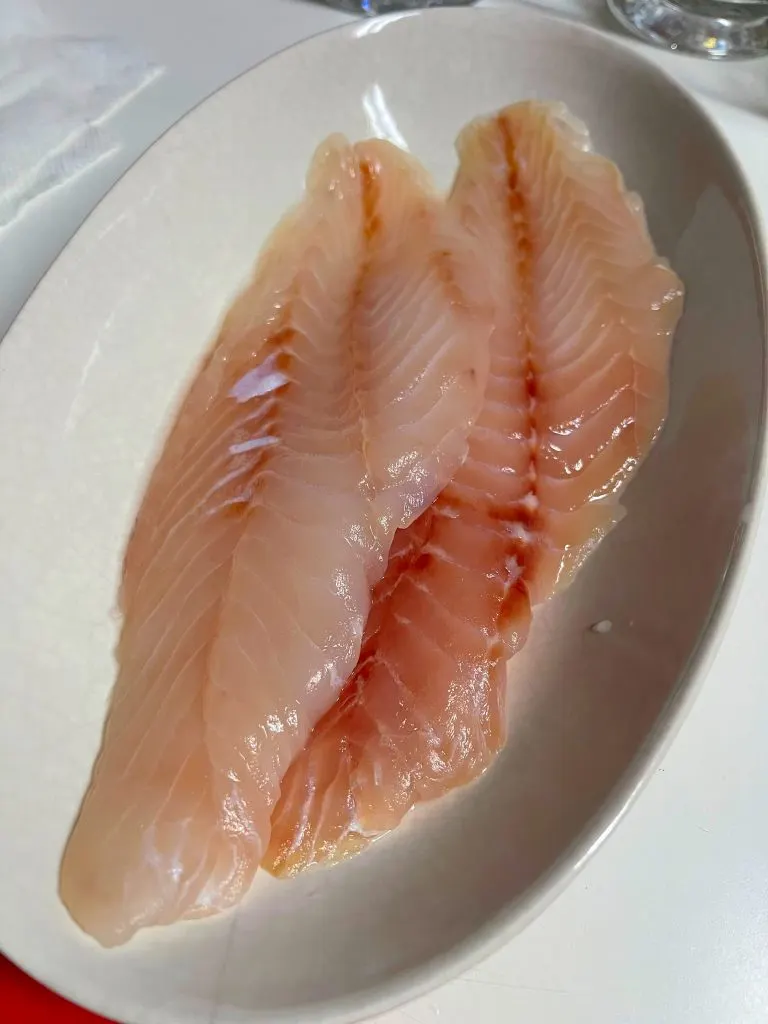
Cod
Cod is a mild and somewhat buttery white fish. It’s got pretty delicate and flaky flesh – which is awesome when the sauce of this dish gets all in between it! It goes with this dish pretty well because the mild taste of cod will highlight the ginger scallion and soy mix.
Sea Bass
Sea bass is another good white fish to go with this dish. Similar to cod – sea bass also is a mild, slightly sweet, white fish. It’s flesh is described as moist moist, buttery, and tender.
Flounder
Flounder is also a mild white fish – it is more delicate so if you want to cook with this fish, you may want to be more gentle or else it could easily fall apart. But outside of that it it is also similar to cod and sea bass – slightly sweet and mild.
Salmon
Salmon might seem like a strange fish I’m listing for this dish, as the other fishes I’ve listed are all mild white fish. However, from personal experience, salmon’s rich, fatty, and buttery flavor profile also goes well with this dish! But is that a surprise? Salmon goes almost with anything!
About the ingredients
If you’re unfamiliar with some of the ingredients, I’ve included an introduction here. I also have an article all about Chinese sauces and condiments here if you ever need to reference anything.
Chili Bean Paste / Doubanjiang
Chilli Bean Paste aka Doubanjiang 豆瓣酱, is a chunky sauce you can buy at the store that is spicy and savory. It’s traditionally made from fermented broad beans, chili peppers, soybeans, salt and flour. There are also different ones you can find, for example some will add spicy chili oil in it already.
Chili Bean Paste is often used in Sichuan food (ex: mapo tofu), which might explain why I love it because I love Sichuan food (and my grandma was from there!). I use it in my Szechuan Chicken, Twice Cooked Pork and Jalapeno Chicken.
You can buy it at your local Asian super market or even on Amazon such as this one: Lee Kum Kee LKK Chili Bean Sauce (Toban Djan).
Rice Wine / Michiu
There’s also a type of alcohol used in this dish, called michiu. Michiu aka Rice Wine is commonly used as a cooking wine and contains about 19.5% alcohol. It’s commonly used in Taiwanese cooking so it’s always in my pantry.
Light Soy Sauce
Light soy sauce (aka 生抽, sheng chou) is the most common type used in Chinese cooking. It’s used to enhance the flavors! This kind of soy sauce is often used in stir fry sauces, marinades, dipping sauces and more.
If you’re not sure what kind of soy sauce you have, this is probably it. Also, if you ever see a recipe that says ‘soy sauce’ and doesn’t specify what kind, this is most likely it.
How to make Red Braised Fish?
Here’s how we make it at home.
First gather your ingredients:
- 1 lb fish , (I am using 2 8-oz grouper filets)
- 2 tbsp vegetable oil
- 1 tbsp chili bean paste (aka doubanjiang)
- 2 tbsp rice wine
- 1 tbsp ginger, julienned
- 5 tbsp light soy sauce
- 1 tbsp minced garlic (optional)
- 1/2 tsp sugar
- 2 scallions, cut 1 inch length
If you haven’t already, cut scallions in to 1 to 2 inch length, and thinly slice ginger and julienne. Pat dry the fish if it is wet.
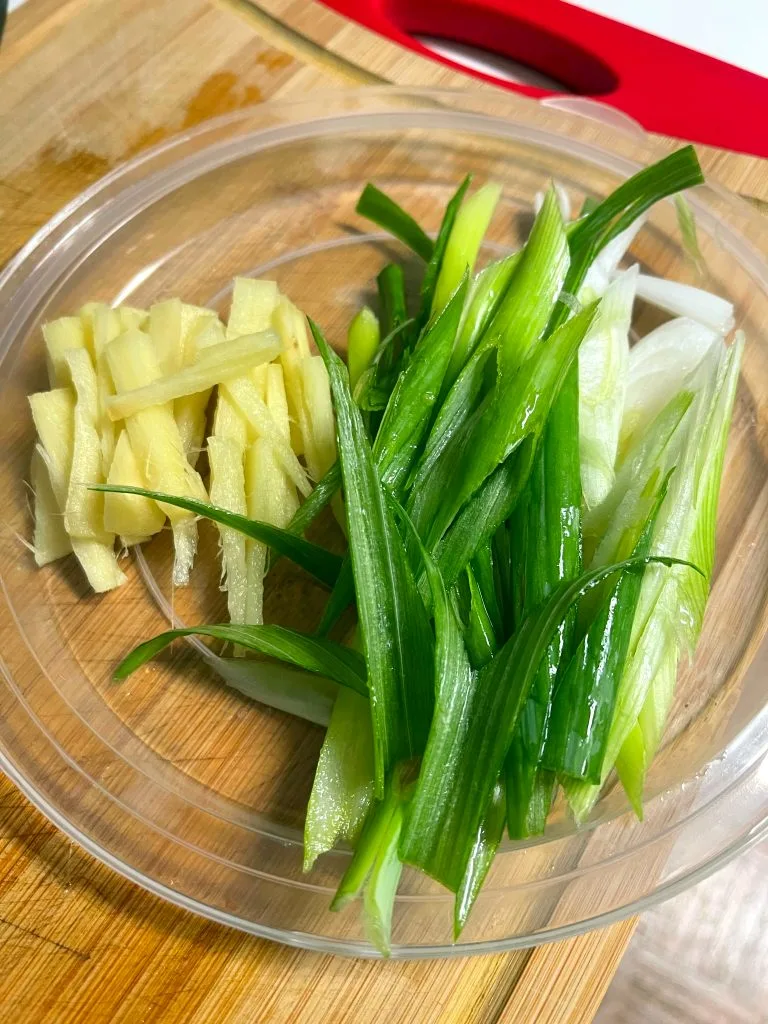
In a cooking pan, add vegetable oil and let it heat up on medium high heat. Once heated, add fish to pan.
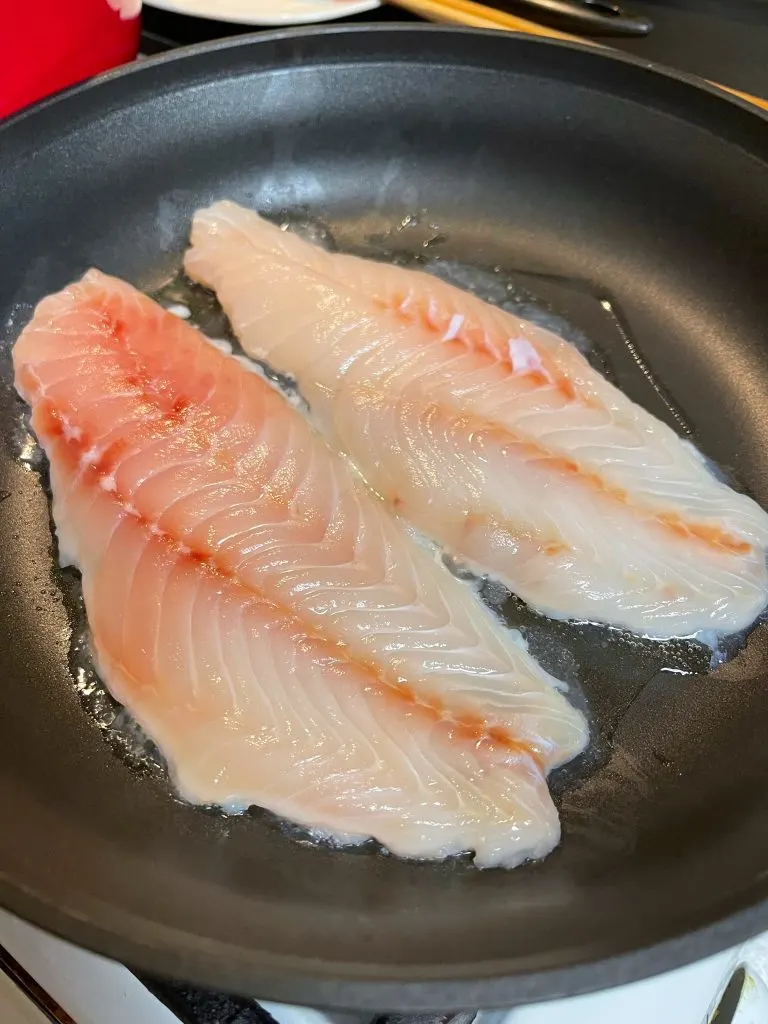
Let it cook for about 2 minutes, and then using a spatulate, gently flip to the other side.
Add the chili bean paste, ginger, rice wine, garlic (optional) and soy sauce, sugar in to the pan and mix well without disturbing the fish. You can do this by adding it in an area and then pan and if needed, use a spatula and swirl everything to mix well. If it gets a little dry, add a little water in to the pan.
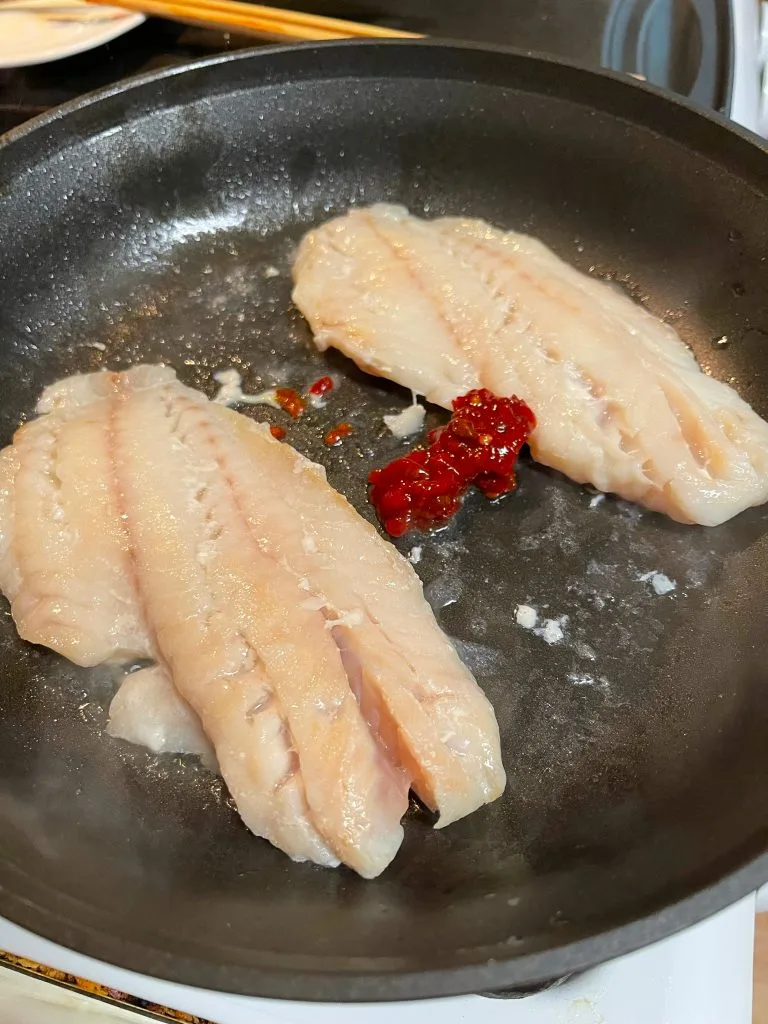
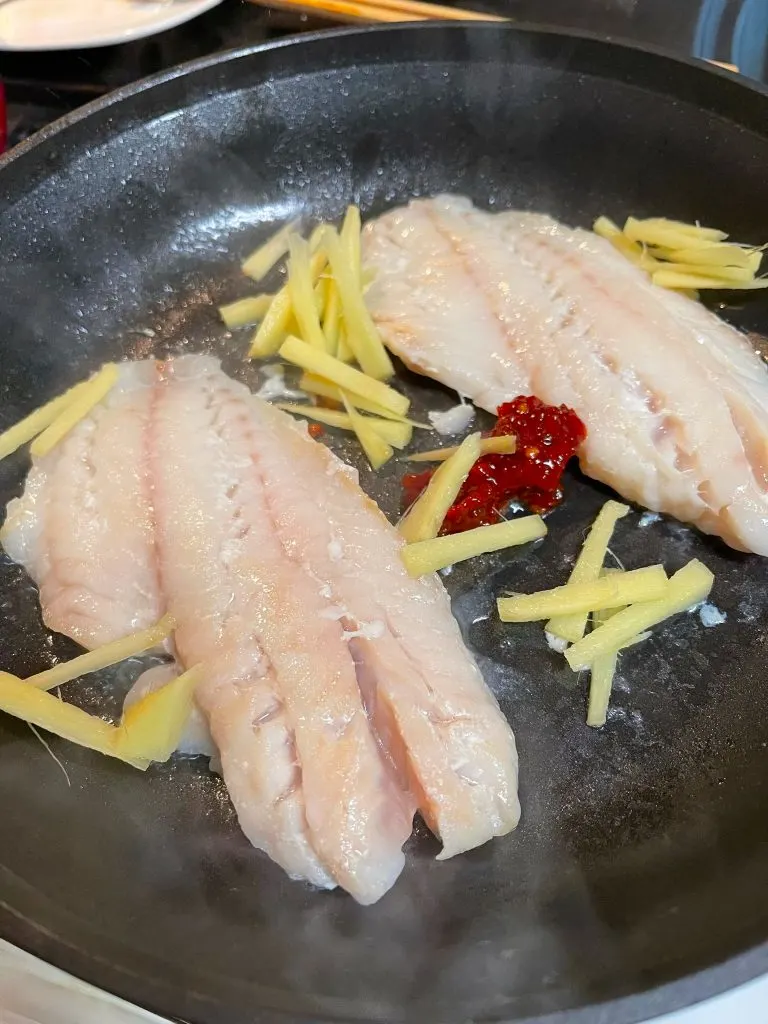
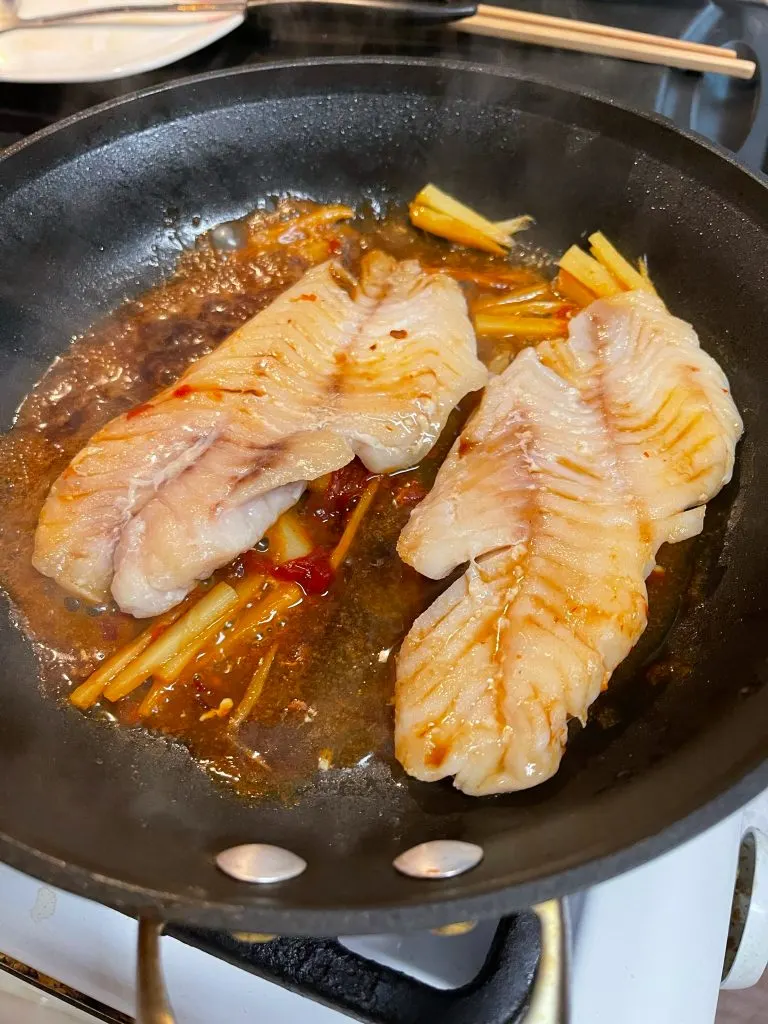
Let it simmer for 2-3 minutes, and then add the scallions and let it cook for another minute.
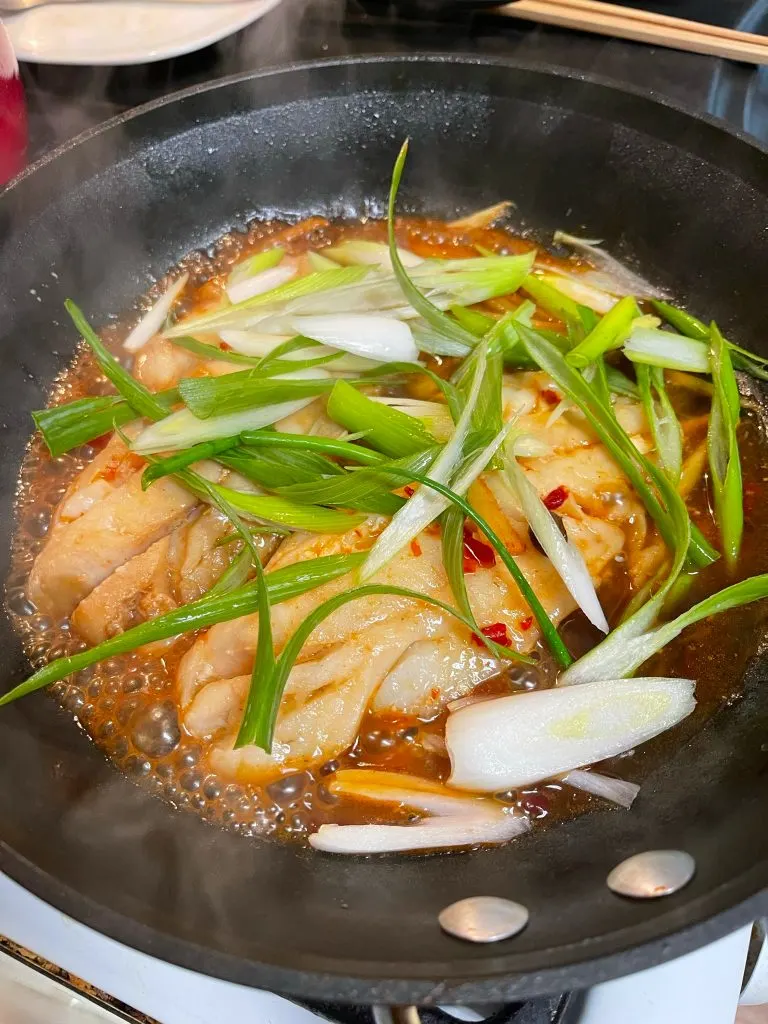
Remove from heat and serve!
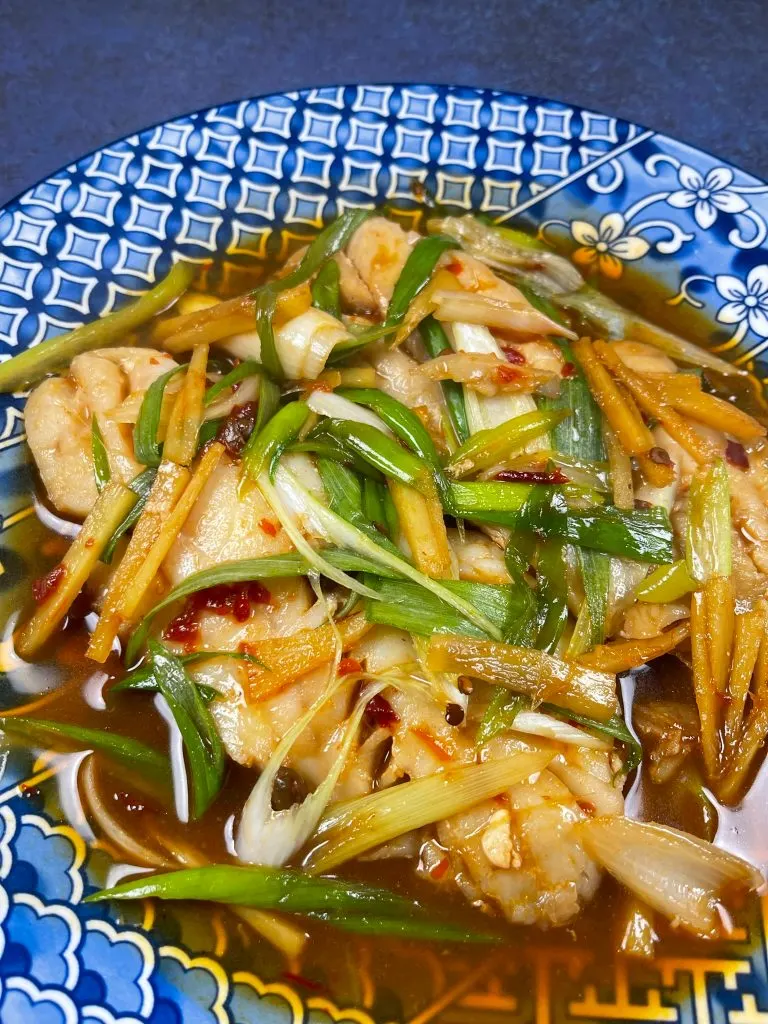
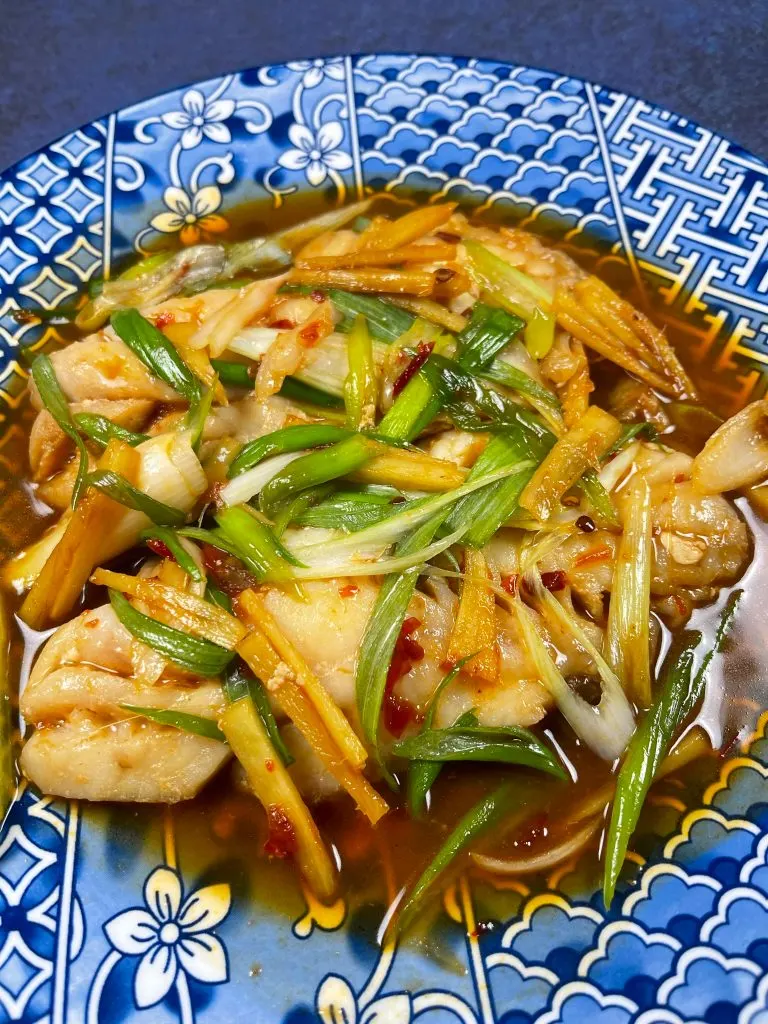
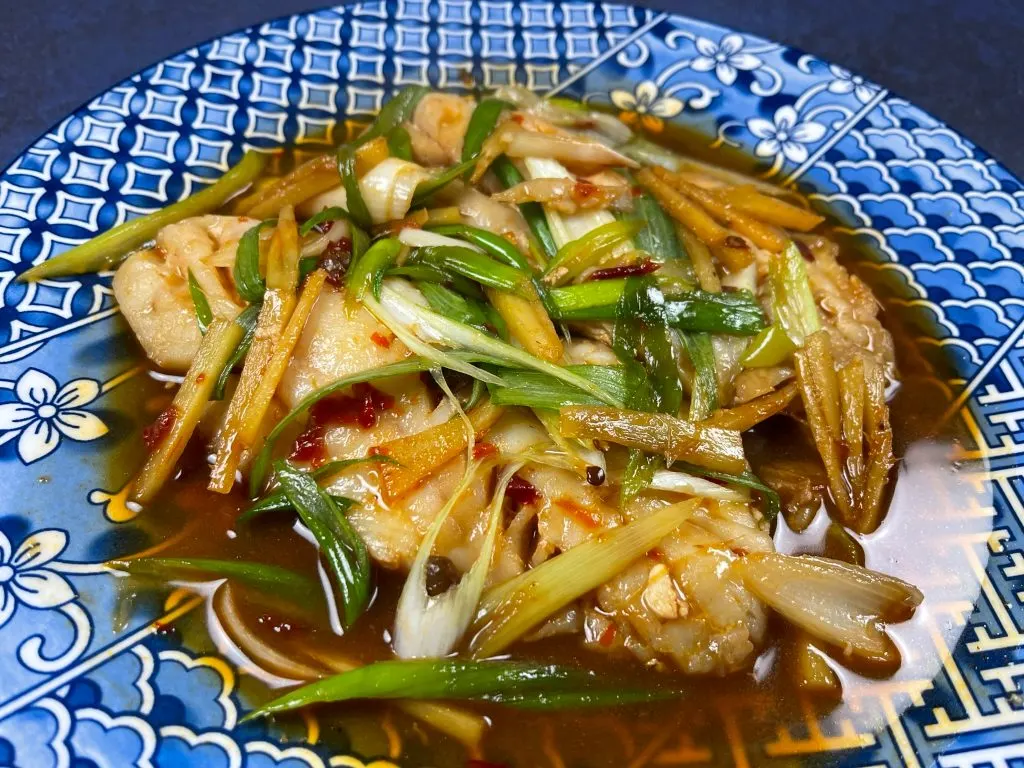
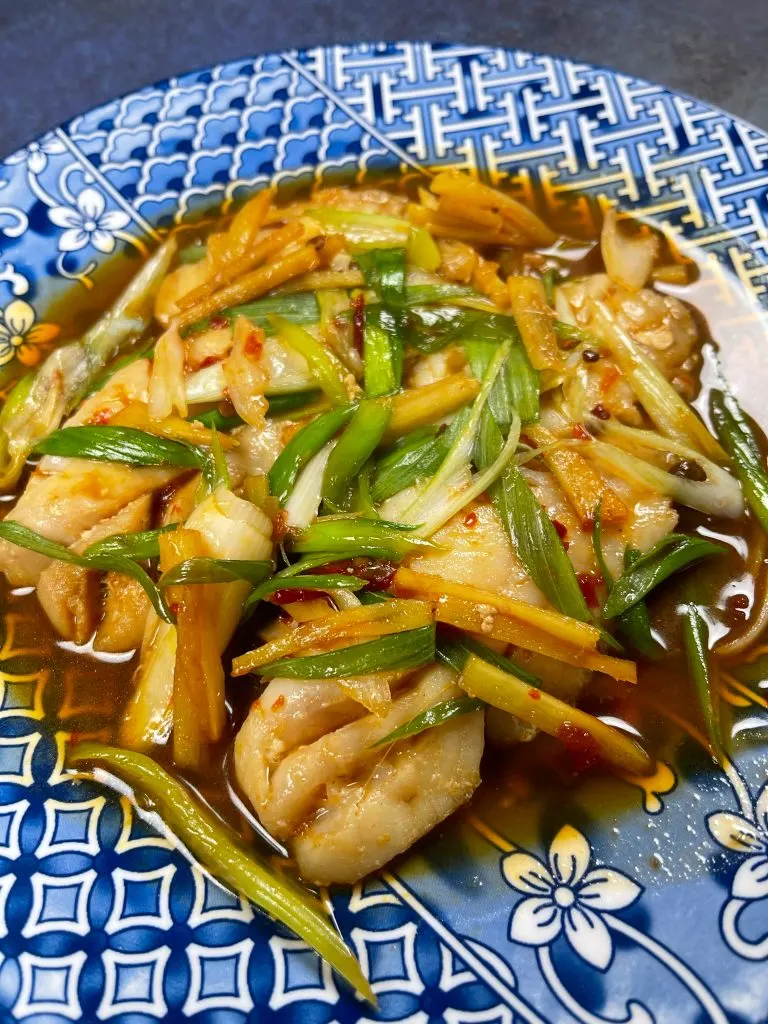
Red Braised Fish (Hong Shao Yu)
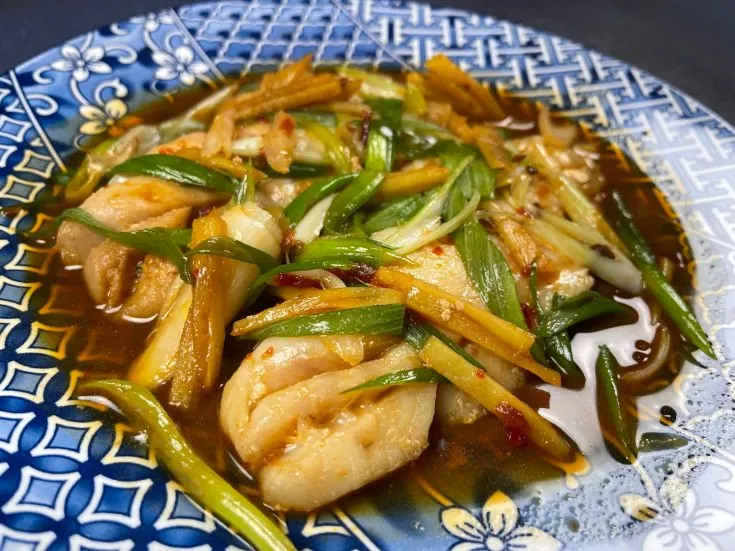
Red braised fish aka Hong Shao Yu, is a very common dish in Chinese and Taiwanese cuisine. It is made with rice wine, ginger, scallions, soy sauce, and the star ingredient of chili bean paste.
Ingredients
- 1 lb fish , (I am using 2 8-oz grouper filets)
- 2 tbsp vegetable oil
- 1 tbsp chili bean paste (aka doubanjiang)
- 2 tbsp rice wine
- 1 tbsp ginger, julienned
- 5 tbsp light soy sauce
- 1 tbsp minced garlic (optional)
- 1/2 tsp sugar
- 2 scallions, cut 1 inch length
Instructions
- If you haven’t already, cut scallions in to 1 to 2 inch length, and thinly slice ginger and julienne. Pat dry the fish if it is wet.
- In a cooking pan, add vegetable oil and let it heat up on medium high heat. Once heated, add fish to pan.
- Let it cook for about 2 minutes, and then using a spatulate, gently flip to the other side.
- Add the chili bean paste, ginger, rice wine, garlic (optional) and soy sauce, sugar in to the pan and mix well without disturbing the fish. You can do this by adding it in an area and then pan and if needed, use a spatula and swirl everything to mix well. If it gets a little dry, add a little water in to the pan.
- Let it simmer for 2-3 minutes, and then add the scallions and let it cook for another minute.
- Remove from heat and serve!
Recommended Products
As an Amazon Associate and member of other affiliate programs, I earn from qualifying purchases.
-
 Sichuan Pixian Boad Bean Paste with Red Chili Oil - 17.6 oz (500g) | Hong You Dou Ban
Sichuan Pixian Boad Bean Paste with Red Chili Oil - 17.6 oz (500g) | Hong You Dou Ban -
 Michiu (Rice Cooking Wine)- 750ml (Pack of 1) by QIAN HU
Michiu (Rice Cooking Wine)- 750ml (Pack of 1) by QIAN HU -
 Lee Kum Kee Premium Light Soy Sauce, 16.9-Ounce + Lee Kum Kee Premium Dark Soy Sauce - 16.9 fl. Ounce + One NineChef Spoon
Lee Kum Kee Premium Light Soy Sauce, 16.9-Ounce + Lee Kum Kee Premium Dark Soy Sauce - 16.9 fl. Ounce + One NineChef Spoon -
 Lee Kum Kee LKK Chili Bean Sauce (Toban Djan) 13 Oz, 1 Pack
Lee Kum Kee LKK Chili Bean Sauce (Toban Djan) 13 Oz, 1 Pack -
 Hiware 10-Pairs Fiberglass Chopsticks - Reusable Chopsticks Dishwasher Safe, 9 1/2 Inches - Black
Hiware 10-Pairs Fiberglass Chopsticks - Reusable Chopsticks Dishwasher Safe, 9 1/2 Inches - Black
Nutrition Information:
Yield:
4Serving Size:
1Amount Per Serving: Calories: 239Total Fat: 10gSaturated Fat: 2gTrans Fat: 0gUnsaturated Fat: 8gCholesterol: 65mgSodium: 1455mgCarbohydrates: 4gFiber: 1gSugar: 1gProtein: 32g
The nutrition information for this recipe is an approximate total per serving. Please double check the nutrition information for your exact ingredients and brands for more precise nutrition information. Keep in mind that if there is a marinade, often times not all the ingredients will be consumed.
Pin for later!
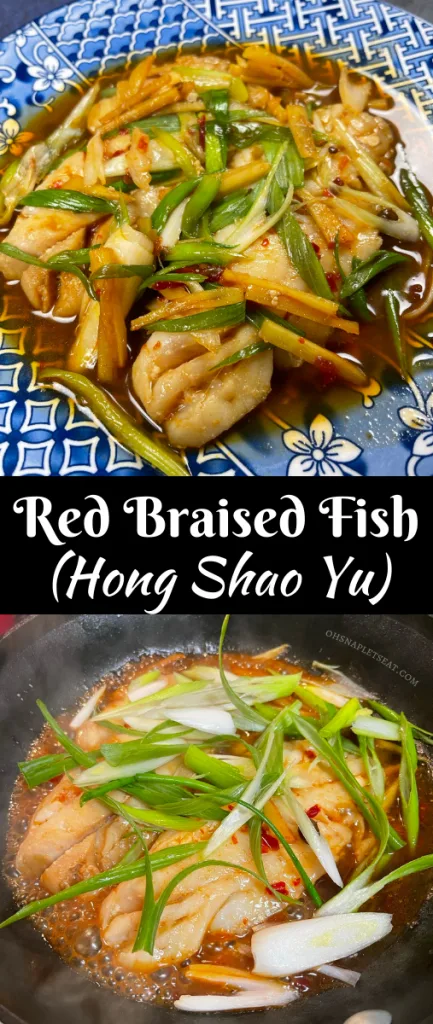
If you like this fish recipe, check out my other tasty fish dishes!

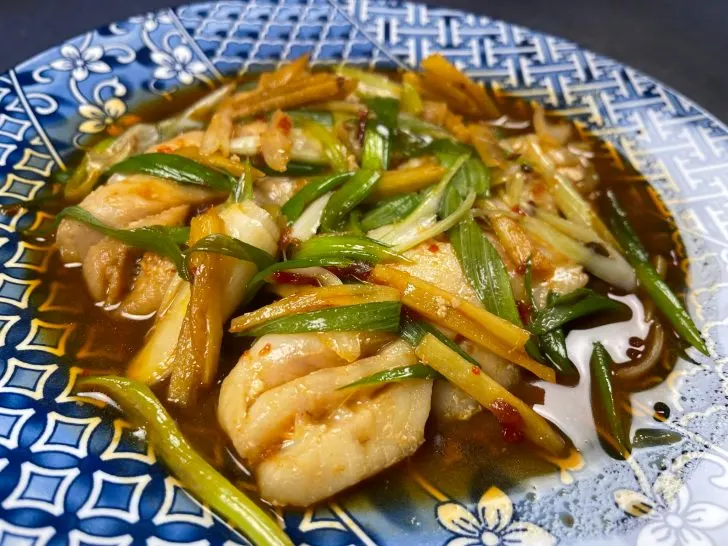
kende
Thursday 1st of February 2024
you confused "hong men" with "hong shao". This is "hong men" and not "hong shao" method of cooking. "Hong men" uses doubanjian while "hong shao" uses burned sugar for that very distinct taste.
TinaTsai
Thursday 1st of February 2024
Hello! Not sure what Chinese characters are you referring to in terms of "Hong men", but using doubanjiang is often used in hong shao (pork, beef, fish) style cooking, and also as sugar as you mentioned too. Using doubanjiang or not is often regional too. Our recipe uses both though.
Karen
Monday 3rd of July 2023
do you mix all the ingredients prior to adding to the pan?
TinaTsai
Monday 3rd of July 2023
you can if you want but i usually just add directly in to pan.